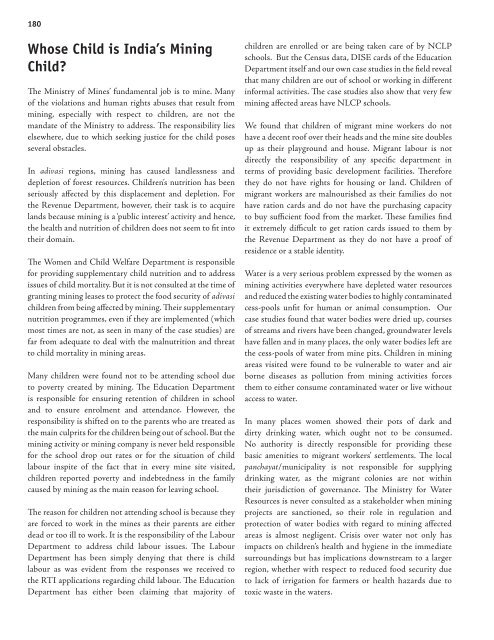Children - Terre des Hommes
Children - Terre des Hommes
Children - Terre des Hommes
You also want an ePaper? Increase the reach of your titles
YUMPU automatically turns print PDFs into web optimized ePapers that Google loves.
180<br />
Whose Child is India’s Mining<br />
Child?<br />
The Ministry of Mines’ fundamental job is to mine. Many<br />
of the violations and human rights abuses that result from<br />
mining, especially with respect to children, are not the<br />
mandate of the Ministry to address. The responsibility lies<br />
elsewhere, due to which seeking justice for the child poses<br />
several obstacles.<br />
In adivasi regions, mining has caused landlessness and<br />
depletion of forest resources. <strong>Children</strong>’s nutrition has been<br />
seriously affected by this displacement and depletion. For<br />
the Revenue Department, however, their task is to acquire<br />
lands because mining is a ‘public interest’ activity and hence,<br />
the health and nutrition of children does not seem to fit into<br />
their domain.<br />
The Women and Child Welfare Department is responsible<br />
for providing supplementary child nutrition and to address<br />
issues of child mortality. But it is not consulted at the time of<br />
granting mining leases to protect the food security of adivasi<br />
children from being affected by mining. Their supplementary<br />
nutrition programmes, even if they are implemented (which<br />
most times are not, as seen in many of the case studies) are<br />
far from adequate to deal with the malnutrition and threat<br />
to child mortality in mining areas.<br />
Many children were found not to be attending school due<br />
to poverty created by mining. The Education Department<br />
is responsible for ensuring retention of children in school<br />
and to ensure enrolment and attendance. However, the<br />
responsibility is shifted on to the parents who are treated as<br />
the main culprits for the children being out of school. But the<br />
mining activity or mining company is never held responsible<br />
for the school drop out rates or for the situation of child<br />
labour inspite of the fact that in every mine site visited,<br />
children reported poverty and indebtedness in the family<br />
caused by mining as the main reason for leaving school.<br />
The reason for children not attending school is because they<br />
are forced to work in the mines as their parents are either<br />
dead or too ill to work. It is the responsibility of the Labour<br />
Department to address child labour issues. The Labour<br />
Department has been simply denying that there is child<br />
labour as was evident from the responses we received to<br />
the RTI applications regarding child labour. The Education<br />
Department has either been claiming that majority of<br />
children are enrolled or are being taken care of by NCLP<br />
schools. But the Census data, DISE cards of the Education<br />
Department itself and our own case studies in the field reveal<br />
that many children are out of school or working in different<br />
informal activities. The case studies also show that very few<br />
mining affected areas have NLCP schools.<br />
We found that children of migrant mine workers do not<br />
have a decent roof over their heads and the mine site doubles<br />
up as their playground and house. Migrant labour is not<br />
directly the responsibility of any specific department in<br />
terms of providing basic development facilities. Therefore<br />
they do not have rights for housing or land. <strong>Children</strong> of<br />
migrant workers are malnourished as their families do not<br />
have ration cards and do not have the purchasing capacity<br />
to buy sufficient food from the market. These families find<br />
it extremely difficult to get ration cards issued to them by<br />
the Revenue Department as they do not have a proof of<br />
residence or a stable identity.<br />
Water is a very serious problem expressed by the women as<br />
mining activities everywhere have depleted water resources<br />
and reduced the existing water bodies to highly contaminated<br />
cess-pools unfit for human or animal consumption. Our<br />
case studies found that water bodies were dried up, courses<br />
of streams and rivers have been changed, groundwater levels<br />
have fallen and in many places, the only water bodies left are<br />
the cess-pools of water from mine pits. <strong>Children</strong> in mining<br />
areas visited were found to be vulnerable to water and air<br />
borne diseases as pollution from mining activities forces<br />
them to either consume contaminated water or live without<br />
access to water.<br />
In many places women showed their pots of dark and<br />
dirty drinking water, which ought not to be consumed.<br />
No authority is directly responsible for providing these<br />
basic amenities to migrant workers’ settlements. The local<br />
panchayat/municipality is not responsible for supplying<br />
drinking water, as the migrant colonies are not within<br />
their jurisdiction of governance. The Ministry for Water<br />
Resources is never consulted as a stakeholder when mining<br />
projects are sanctioned, so their role in regulation and<br />
protection of water bodies with regard to mining affected<br />
areas is almost negligent. Crisis over water not only has<br />
impacts on children’s health and hygiene in the immediate<br />
surroundings but has implications downstream to a larger<br />
region, whether with respect to reduced food security due<br />
to lack of irrigation for farmers or health hazards due to<br />
toxic waste in the waters.






